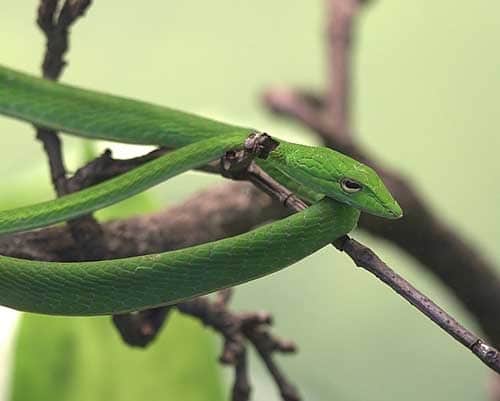Description:
Captive Housing: With vine snakes, up is good, and the taller the better. An enclosure measuring 36 by18 inches and at least 36 inches tall would nicely house a pair of 4-foot snakes. There are glass reptile enclosures available in these dimensions, or you can construct your own enclosure. Vine snakes live in trees and bushes, so you need to decorate the enclosure with this in mind. The substrate can consist of a few inches of cypress mulch with an inch of sphagnum moss on top. This is a very good substrate for keeping a high humidity level without being sopping wet. After you have the substrate in place, add branches, sticks and vines (real or artificial). You can also include live plants. The more bushy the enclosure the better. There are some dandy magnetic water bowls and hides available at reptile specialty stores that are great for arboreal animals, such as vine snakes, that seldom descend to the floor of their enclosures. I place three lights at the top of a vine snake cage. First, an incandescent heat lamp fixture is placed on top of the enclosure’s metal screen top to provide a hot spot of 95 to 100 degrees Fahrenheit at the top of the enclosure. The temperature will diminish approaching the bottom, and it’s best to keep the bottom of the tank at about 80 degrees. Although not proven to be needed for the health of vine snakes, I like to include a UVB lamp at the top of the enclosure; one that’s about 26 watts works well. Although the jury is out on whether or not UVB benefits the snakes, I figure it won’t hurt to provide it. My third light is a 75-watt infrared bulb or ceramic heat emitter. Use a timer to set the UV and heat lamps for a 14-hour day, turning off at night. Another timer can then turn on the emitter or infrared lamp for 10 hours during the night. The goal is to have about a 10 to 15-degree drop in temperature at night. Humidity is a major factor when keeping vine snakes. I recommend using a Zoo Med Reptifogger to maintain humidity between 75 and 90 percent. Zoo Med also offers a regulator to maintain the proper temperature and humidity for both the Reptifogger and the heat lamps. Diet: Vine snakes primarily eat lizards. They will also consume small birds and mammals in the wild. In captivity, it is possible to switch them over to rodents—but sometimes not. It depends on the snake. We feed ours green anoles; two to three a week per snake seems to do just fine for these high-metabolism animals. I usually leave the anole to roam about the enclosure so the snake can consume it at its leisure. If you’re housing two or more snakes together, separate them during feeding so they don’t hassle each other over the same anole. What’s Available: Vine snakes can be found at specialty reptile stores, reptile shows and on the Internet. Ninety-nine percent of those available are imports that enter the U.S. in various degrees of health, from looking to be at death’s door to perfect in looks and health. Always observe and handle one before purchasing. Look for a firm body and an alert, almost snotty attitude. Make sure the snake is eating, too. Once you’ve got your snake, I recommend taking it to a good herp veterinarian. Vine snakes often arrive in this country with a pretty good load of parasites, and treatment for this will ensure a lively and healthy snake for you to enjoy for years. Also make sure that your new snake is thoroughly hydrated by soaking it in lukewarm water for an hour or so several days a week. Once you get over the “importation hump,“ you are good to go. Extra: Vine snakes are ambush predators and will sit perfectly still waiting for prey to come within range of their lightning-fast strike. Ken Foose produced his first captive-bred snakes at age 11. With a master’s degree in zoology, he has been both a zookeeper and curator. He opened Exotic Pets, which specializes in reptiles and amphibians, in Las Vegas in 1991. He is currently president of the International Herpetological Symposium.
Habitat:
Swamps, lowland jungles and tropical forests
Range:
From Southeast Asia to Indo China, neighboring countries and islands
Scientific Name: Ahaetulla spp
Species Group:
Family:
Size:
Level: advanced
Weight:
Dangerous: No


